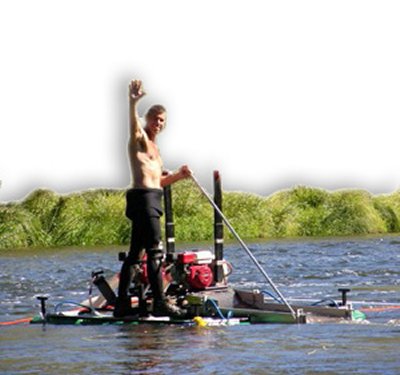
“Here is some further explaination of the Karuk Tribe Lawsuit against the California DFG to change dredging regulations…”
(Forum post dated 29 January)
Hello Everyone,
The next round of briefs have been filed in the Karuk’s lawsuit against the California Department of Fish & Game (DFG). The key documents can be located on the special page we have created for this litigation. We have not put all of the documents up there, because there are just too many. A lot of effort is going into this litigation from all sides! While you guys are invited and encouraged to read the briefs for yourself, here is my own short summary about what is happening:
There are two important issues to be decided in the case at the present time. I understand both of these motions will be addressed by the Court during the upcoming hearing scheduled for 9 February in Alameda Superior Court.
1) Under The New 49’er banner, we have motioned to Intervene in the litigation. PLP has also submitted a similar motion to Intervene. Our position on this is that the Miners are actually the Real Parties in Interest, since it is our regulations that will potentially affected by the litigation.
In opposition to our Motion to Intervene, the Karuks have argued that we don’t really have any property rights because we are just a bunch of recreationalists with no rights under the mining laws. DFG has argued that even if we do have a property interest in the mining claims, we do not have any property interest in the annual permits which California issues to dredgers. Therefore, DFG has argued that we should not be allowed any standing in the ongoing litigation.
I believe our attorneys have done an excellent job presenting our argument that since modified regulations will reduce or eliminate access to our mining properties, and the Administrative Procedures Act (APA) of California forbids DFG to modify our regulations without allowing us an opportunity to be heard, and the yearly permits directly affect how me may access our property, that we certainly do have a place in this litigation.
2) We have also submitted a motion for the judge to reject the Stipulation which has been submitted to the Court by DFG and the Karuks to end the litigation. You guys will recall that this Stipulation creates an injunction preventing DFG from issuing dredge permits for the Main Stem of the Salmon River, Elk Creek, Indian Creek and other waterways. The injunction also reduces the dredging season on the Klamath and Scott Rivers to 1 July through 15 September. These are very substantial changes in our suction dredge regulations. DFG began implementing them in November of 2005 without so much as a single notice to the mining community or the many other people that will be adversely affected.
In opposition to our motion, the Karuks have submitted a very substantial volume of material to the Court, including Declarations from three fish biologists. Most of the material presented basically rehashes the same old arguments about dredging up the fish eggs and swallowing up juvenile salmonids. There is no acknowledgement by the Karuks that existing regulations have already addressed these very same issues. They have not provided any factual information to show how existing regulations do not provide adequate protection for the Coho salmon, or any factual information to demonstrate that a single fish has ever been harmed by a suction dredger. The Karuk’s position is that suction dredging should be presumed to be harmful unless proven otherwise (How is it even possible to prove “no harm” from any human activity?).
DFG’s opposition to our motion is based upon an argument that since their Stipulated Agreement was created during ongoing litigation, they really have not made any changes to our regulations at all. Therefore, they argue that they are not bound by the provisions of APA and the California Environmental Protection Act (CEQA) which require public participation when regulations are changed, even under emergency conditions. Interestingly, DFG’s position also is that they have done everything right in the way they have managed the suction dredge regulations during the past, including affording adequate protection to the Coho salmon. They make no claims that existing regulations do not protect the Coho. Their position is that the Stipulated Agreement simply offers additional protection because of the unproven arguments brought forward by the Karuks in the litigation. DFG argues that it is well within the authority of the Court to Order an injunction that reduces our dredging seasons. Never mind that there has yet to be any contested hearing or public debate to determine if any additional protection is even necessary!
In turn, our attorneys have argued that no matter what kind of spin they want to put on it, the fact is that the written regulations presently being issued by DFG have been changed to reduce our dredging seasons. The changes are very substantial. The fact that DFG is arguing that the earlier regulations were already in compliance with CEQA and were providing adequate protection to fish does not go well with a decision to shorten our mining seasons. We have rebutted the Declarations written by Karuk biologists with Declarations from other biologists who actually have field experience along the waterways that are being fought over in this litigation. We have also presented a Declaration which outlines just how substantial these regulatory changes are and how much damage will be caused to Miners and others.
Our main argument is that the Administrative Process in California was enacted to mandate State Agencies (DFG) to allow all interested parties to participate, and to mandate that State agencies weigh and balance all of the relevant factors to create reasonable regulations that resolve perceived problems in such a manner as to impose the least amount of restrictions upon productive activity. We argue that it is wrong for the Court to allow DFG to skirt around its important obligations to the public by sneaking behind closed doors with anti-industry groups to impose more restrictive regulations by Court Order — even without so much as a contested hearing.
As the court hearing is postponed until 9 February, I gather that DFG and the Karuks will be allowed one more opportunity to rebut our arguments in writing to the Court. I assume there will also be some oral arguments during the hearing.
We should keep our hopes up that this goes our way. If it doesn’t, we are already in early planning for the appeal. What good is the full public administrative process if a State agency can later go behind closed doors with an anti-industry group and modify industry regulations without having to justify the changes to the industry or the affected public?
We are also in the beginning stages of organizing a class action lawsuit to force the State of California to compensate all affected mining claim and private property owners for the reduced value of our/their holdings. The State cannot have it both ways. If the Court agrees that it is so important to stop or reduce the mining activity on these properties for the public good, then the State should be prepared to financially compensate property owners for our losses.
We are also exploring the possibility of filing a counter claim against the State of California for allowing the Karuks to dip net and kill the very same fish that they are trying to protect from us. Our research to date appears to show that the Karuk’s fishing practices should not be allowed under the very same laws they are using to try and eliminate the miners. This is not about retaliation. There just comes a point where we have to be looking at all of the potential negative impacts upon these fish. If conditions are so critical that serious consideration is being given to eliminating or reducing our mining seasons, then why are the Karuks being allowed to kill as many of the fish as they want out of the river? Where is the CEQA document that supports that decision by the State? I gather that other industry groups in Siskiyou County, who are also being pressured to make substantial and costly concessions, are asking the very same question.
If you possibly can, please be present at the hearing in Alameda County on February 9th. It is important that Miners are present. I know it is a long way away from our territory. Still, we need to be there in force if we can.
Once more, I am asking for another $10 donation, from anyone who can afford it, to help support our legal fund. It is vital that we finish paying attorney fees for December before we receive the January billing. Although we are close, we have not accomplished that, yet.
You guys should know that I am experiencing more stress about paying our lawyers, than I am about the litigation. The lawyers are doing a great job. We are fighting this battle as well as it can be done. The rest is up to fate. It is a good feeling to know you have done everything that you can to solve a problem!
My concern is over our future capability to do the same thing. We must keep up with our attorney bills so that we do not get overwhelmed by the process. All I can do is yell the charge. You guys are the force which will allow our side to win this battle. Now is the time to charge forward!
Thank you for whatever you can do!
Sincerely,
Dave Mack







